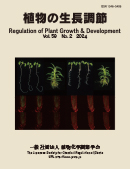Volume 59, Issue 2
Displaying 1-14 of 14 articles from this issue
- |<
- <
- 1
- >
- >|
The Society Awards Lectures
The JSCRP Award for the Encouragement of Young Scientists
-
2024 Volume 59 Issue 2 Pages 69-77
Published: December 21, 2024
Released on J-STAGE: July 20, 2025
Download PDF (1254K)
Feature Articles
-
2024 Volume 59 Issue 2 Pages 78-80
Published: December 21, 2024
Released on J-STAGE: July 20, 2025
Download PDF (2547K) -
2024 Volume 59 Issue 2 Pages 81-86
Published: December 21, 2024
Released on J-STAGE: July 20, 2025
Download PDF (1267K) -
2024 Volume 59 Issue 2 Pages 87-94
Published: December 21, 2024
Released on J-STAGE: July 20, 2025
Download PDF (1834K) -
2024 Volume 59 Issue 2 Pages 95-99
Published: December 21, 2024
Released on J-STAGE: July 20, 2025
Download PDF (5152K) -
2024 Volume 59 Issue 2 Pages 100-108
Published: December 21, 2024
Released on J-STAGE: July 20, 2025
Download PDF (853K)
Reviews
-
2024 Volume 59 Issue 2 Pages 109-114
Published: December 21, 2024
Released on J-STAGE: July 20, 2025
Download PDF (6118K) -
2024 Volume 59 Issue 2 Pages 115-124
Published: December 21, 2024
Released on J-STAGE: July 20, 2025
Download PDF (1856K) -
2024 Volume 59 Issue 2 Pages 125-134
Published: December 21, 2024
Released on J-STAGE: July 20, 2025
Download PDF (1721K) -
2024 Volume 59 Issue 2 Pages 135-143
Published: December 21, 2024
Released on J-STAGE: July 20, 2025
Download PDF (2300K) -
2024 Volume 59 Issue 2 Pages 144-152
Published: December 21, 2024
Released on J-STAGE: July 20, 2025
Download PDF (2188K) -
2024 Volume 59 Issue 2 Pages 153-162
Published: December 21, 2024
Released on J-STAGE: July 20, 2025
Download PDF (761K)
Research Note
-
2024 Volume 59 Issue 2 Pages 163-173
Published: December 21, 2024
Released on J-STAGE: July 20, 2025
Download PDF (3896K)
Science Saloon
-
2024 Volume 59 Issue 2 Pages 174-178
Published: December 21, 2024
Released on J-STAGE: July 20, 2025
Download PDF (3171K)
- |<
- <
- 1
- >
- >|
